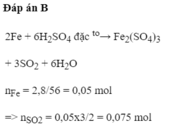Hãy nhập câu hỏi của bạn vào đây, nếu là tài khoản VIP, bạn sẽ được ưu tiên trả lời.

PTHH: \(Fe+H_2SO_4\rightarrow FeSO_4+H_2\uparrow\)
Ta có: \(\left\{{}\begin{matrix}n_{Fe}=\dfrac{22,4}{56}=0,4\left(mol\right)\\n_{H_2SO_4}=\dfrac{24,5}{98}=0,25\left(mol\right)\end{matrix}\right.\) \(\Rightarrow\) Fe còn dư
\(\Rightarrow\left\{{}\begin{matrix}n_{H_2}=0,25\left(mol\right)\\n_{Fe\left(dư\right)}=0,15\left(mol\right)\end{matrix}\right.\) \(\Rightarrow\left\{{}\begin{matrix}V_{H_2}=0,25\cdot22,4=5,6\left(l\right)\\m_{Fe\left(dư\right)}=0,15\cdot56=8,4\left(g\right)\end{matrix}\right.\)
Số mol của sắt
nFe = \(\dfrac{m_{Fe}}{M_{Fe}}=\dfrac{22,4}{56}=0,4\left(mol\right)\)
Số mol của axit sunfuric
nH2SO4 = \(\dfrac{m_{H2SO4}}{M_{H2SO4}}=\dfrac{24,5}{98}=0,25\left(mol\right)\)
Pt : Fe + H2SO4 → FeSO4 + H2\(|\)
1 1 1 1
0,4 0,25 0,25
a) Lập tỉ số so sánh : \(\dfrac{0,4}{1}>\dfrac{0,25}{1}\)
⇒ Fe dư , H2SO4 phản ứng hết
⇒ Tính toán dựa vào số mol của H2SO4
Số mol của khí hidro
nH2 = \(\dfrac{0,25.1}{1}=0,25\left(mol\right)\)
Thể tích của khí hidro
VH2 = nH2 . 22,4
= 0,25 . 22,4
= 5,6 (l)
b) Số mol dư của sắt
ndư = nban đầu - nmol
= 0,4 -(0,25 . 1)
= 0,15 (mol)
Khối lượng dư của sắt
mdư = ndư . MFe
= 0,15 . 56
= 8,4 (g)
Chúc bạn học tốt

\(a)n_{Fe}=\dfrac{5,6}{56}=0,1mol\\ n_{Mg}=\dfrac{4,8}{24}=0,2mol\\ Fe+2HCl\rightarrow FeCl_2+H_2\)
0,1 0,2 0,1 0,1
\(Mg+2HCl\rightarrow MgCl_2+H_2\)
0,2 0,4 0,2 0,2
\(V_{H_2}=\left(0,1+0,2\right).22,4=6,72l\\ b)V_{ddHCl}=\dfrac{0,2+0,4}{2}=0,3l\\ c)m_{muối}=0,1.127+95.0,2=31,7g\)

a) $Fe + H_2SO_4 \to FeSO_4 + H_2$
b) Ta thấy :
$n_{Fe} = \dfrac{5,6}{56} = 0,1 > n_{H_2SO_4} = \dfrac{1,96}{98} = 0,02$
Do đó Fe dư
$n_{Fe\ pư} = n_{H_2SO_4} = 0,02(mol)$
$m_{Fe\ dư} = 5,6 - 0,02.56 = 4,48(gam)$
c)
$n_{FeSO_4} = n_{H_2SO_4} = 0,02(mol) \Rightarrow m_{FeSO_4} = 0,02.152 = 3,04(gam)$
d)
$n_{H_2} = n_{H_2SO_4} = 0,02(mol)$
$V_{H_2} = 0,02.22,4 = 0,448(lít)$
nFe=5,6/56=0,1(mol)
nH2SO4=1,96/98=0,02(mol)
a) PTHH: Fe + H2SO4 -> FeSO4 + H2
b) Ta có: 0,02/1 < 0,1/1
=> Fe dư, H2SO4 hết => Tính theo nH2SO4.
=> nFe(p.ứ)=nFeSO4=nH2=nH2SO4=0,02(mol)
=>nFe(dư)=0,1 - 0,02=0,08(mol)
c) =>mFe(dư)= 0,08.56=4,48(g)
d) V(H2,đktc)=0,02.22,4=0,448(l)
Chúc em học tốt!

Đặt a, b, c là số mol Mg, Al, Fe
-> mA = 24a + 27b + 56c = 4,3
Với NaOH =>; nH2 = 1,5b = 0,075
Với HCl =>; nH2 = a + 1,5b + c = 0,135
=>a = 0,01; b = 0,05; c = 0,05
=> A gồm Mg (5,47%), Al (30,75%) và Fe (63,78%)
Al(OH)3 tan trong NaOH dư nên chất rắn còn lại gồm MgO (a) và Fe2O3 (0,5c)
=> m rắn = 4,4 gam
Dễ thấy b = c = 5a nên trong x gam A chứa Mg (y), Al (5y) và Fe (5y)
Bảo toàn electron: 2y + 3.5y + 2.5y = 0,6.3
=>y = 1/15
=>x = 439/15 gam

a) Theo de bai ta co : \(\left\{{}\begin{matrix}nFe=\dfrac{4,2}{56}=0,075\left(mol\right)\\nH2SO4=0,05.1=0,05\left(mol\right)\end{matrix}\right.\)
Ta co PTHH :
\(Fe+H2SO4->FeSO4+H2\uparrow\)
0,05mol....0,05mol........0,05mol...0,05mol
Theo PTHH ta co : \(nFe=\dfrac{0,075}{1}mol>nH2SO4=\dfrac{0,05}{1}mol=>nFe\left(du\right)\) ( tinh theo nH2SO4)
mFe(du) = (0,075 - 0,05).56 = 1,4(g)
b) The tich cua H2 dktc la :
\(VH2\left(dktc\right)=0,05.22,4=1,12\left(l\right)\)
c) PTHH :
\(2Fe+6H2SO4\left(dac\right)-^{t0}->Fe2\left(SO4\right)3+3SO2\uparrow+6H2O\)
0,075mol.............................................0,0375mol.......0,1125mol
=> \(\left\{{}\begin{matrix}mFe2\left(SO4\right)3=0,0375.160=6\left(g\right)\\VSO2\left(dktc\right)=0,1125.22,4=2,52\left(l\right)\end{matrix}\right.\)
Fe + H2SO4 -> FeSO4 + H2
nFe=\(\dfrac{4,2}{56}=0,075\left(mol\right)\)
nH2SO4=0,05.1=0,05(mol)
Vì 0,05<0,075 nên Fe dư 0,025(mol)
mFe dư=0,025.56=1,4(g)
Theo PTHH ta có:
nH2=nH2SO4=0,05(mol)
VH2=22,4.0,05=1,12(lít)
c;
2Fe + 6H2SO4(đ,n) -> Fe2(SO4)3 + 3SO2 + 6H2O
Theo PTHH 2 ta có:
nFe2(SO4)3=\(\dfrac{1}{2}\)nFe=0,0375(mol)
nSO2=\(\dfrac{3}{2}\)nFe=0,1125(mol)
mFe2(SO4)3=400.0,0375=15(g)
VSO2=22,4.0,1125=2,52(lít)


\(Fe+H_2SO_4\rightarrow FeSO_4+H_2\\ n_{Fe}=\dfrac{2,8}{56}=0,05\left(mol\right)\\ n_{H_2}=n_{Fe}=0,05\left(mol\right)\\ \Rightarrow V_{H_2}=0,05.22,4=1,12\left(l\right)\)